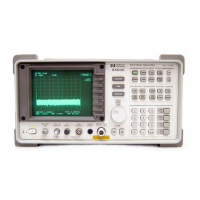Chapter 12 645
Display/Power Supply Section
A6 Power Supply Assembly
4. Check A6TP304 for +28 Vdc.
5. Check A6TP305 for −12.6 Vdc.
6. Check A6TP308 for +5 Vdc.
7. If the voltages measured above are correct but the power supply
LEDs on the A2 controller assembly are not lit, check W1.
8. If the voltages are low, disconnect W1 from A6J1 and measure the
test point voltages again. Unless a dummy load is connected to the
A6 power supply, the voltages should return to their nominal
voltages but be unregulated.
9. If the voltages do not return to near their nominal range, the A6
power supply is probably at fault.
10.If the +5 V supply is low, suspect the +5 V regulator or the feedback
circuit. To check the feedback circuit, measure the voltage of the +5
V reference (U305 pin 6) and the ±5 V references to the voltage
regulators (U306B pin 7 and U306D pin 14).
11.Check output of U306A pin 1. If the feedback circuit is working
properly, the output of U306A should be near +13 Vdc.
12.Check output of U302; its output should be high if the feedback
circuit is working properly.
High Voltage Supplies (8560E)
1. Press LINE to turn spectrum analyzer off, disconnect the power cord,
and remove the power supply shield.
2. Connect the negative lead of a DVM to A6TP401 and positive lead to
A6TP405.
3. Press LINE to turn spectrum analyzer on.
4. If the voltage displayed on the DVM is approximately +110 Vdc and
the rear panel CRT +110 VDC ON indicator is lit, the A6A1 HV
module is probably at fault.
NOTE Ideally, the DVM should read the voltage written on the label of the
A6A1 HV module. If necessary, perform the "High Voltage Power
Supply" adjustment in Chapter 2.
5. If the DVM does not read approximately +110 Vdc, measure the
voltage on A6U401 pin 10. This is the HV_SHUT_DOWN signal and
should be near +5 Vdc.
6. If HV_SHUT_DOWN is low, suspect a bad connection along W8
between the A6 power supply and the 17 CRT driver.
7. If HV_SHUT_DOWN is correct, connect an oscilloscope to A6TP402.
Connect the scope probe negative lead to TP401. Set the oscilloscope

